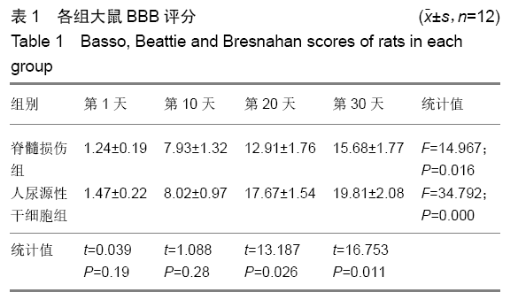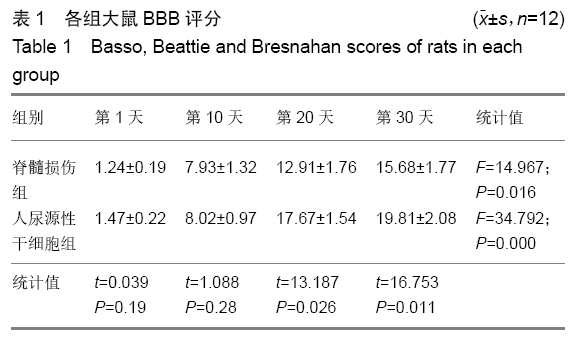[1] KUHL E. Mechanical Cues in Spinal Cord Injury.Biophys J. 2018;115(5):751-753.
[2] JI WC, ZHANG XW, QIU YS. Selected suitable seed cell, scaffold and growth factor could maximize the repair effect using tissue engineering method in spinal cord injury. World J Exp Med. 2016;6(3):58-62.
[3] ZHANG Y, LIU G, KROPP BP. Re-epithelialization of demucosalized stomach patch with tissue-engineered urothelial mucosa combined with Botox A in bladder augmentation. BJU Int. 2012;110(2 Pt 2):E106-112.
[4] BODIN A, BHARADWAJ S, WU S, et al. Tissue-engineered conduit using urine-derived stem cells seeded bacterial cellulose polymer in urinary reconstruction and diversion. Biomaterials. 2010;31(34):8889-8901.
[5] 李智,吴海辉.人尿液干细胞联合硫酸软骨素酶ABC对脊髓损伤后神经生长因子和脑源性神经营养因子表达的影响[J].中国修复重建外科, 2017,11(31):1377-1383.
[6] WANG C, HEI F, JU Z, et al. Differentiation of Urine-Derived Human Induced Pluripotent Stem Cells to Alveolar Type II Epithelial Cells. Cell Reprogram. 2016;18(1):30-36.
[7] 朱琼,皋月娟,高顺记,等.神经干细胞的培养鉴定及分化[J].中国组织工程研究,2017,21(17):2708-2713.
[8] LANG R, LIU G, SHI Y, et al. Self-renewal and differentiation capacity of urine-derived stem cells after urine preservation for 24 hours. PLoS One. 2013;8(1):e53980.
[9] ZHANG Y, MCNEILL E, TIAN H, et al. Urine derived cells are a potential source for urological tissue reconstruction. J Urol. 2008;180(5):2226-2233.
[10] QIN H, ZHU C, AN Z, et al. Silver nanoparticles promote osteogenic differentiation of human urine-derived stem cells at noncytotoxic concentrations. Int J Nanomedicine. 2014;9: 2469-2478.
[11] ARCOLINO FO, ZIA S, HELD K, et al. Urine of Preterm Neonates as a Novel Source of Kidney Progenitor Cells. J Am Soc Nephrol. 2016;27(9):2762-2770.
[12] ARAS Y, SABANCI PA, KABATAS S, et al. The Effects of Adipose Tissue-Derived Mesenchymal Stem Cell Transplantation During the Acute and Subacute Phases Following Spinal Cord Injury. Turk Neurosurg. 2016;26(1): 127-139.
[13] ZENG X, QIU XC, MA YH, et al. Integration of donor mesenchymal stem cell-derived neuron-like cells into host neural network after rat spinal cord transection. Biomaterials. 2015;53:184-201.
[14] WU S, WANG Z, BHARADWAJ S, et al. Implantation of autologous urine derived stem cells expressing vascular endothelial growth factor for potential use in genitourinary reconstruction. J Urol. 2011;186(2):640-647.
[15] LIU G, WANG X, SUN X, et al. The effect of urine-derived stem cells expressing VEGF loaded in collagen hydrogels on myogenesis and innervation following after subcutaneous implantation in nude mice. Biomaterials. 2013;34(34): 8617-8629.
[16] SHAIKH N, RHAMAN MA, RAZA A, et al. Prolonged bradycardia, asystole and outcome of high spinal cord injury patients: Risk factors and management. Asian J Neurosurg. 2016;11(4):427-432.
[17] GRÉGOIRE CA, GOLDENSTEIN BL, FLORIDDIA EM, et al. Endogenous neural stem cell responses to stroke and spinal cord injury. Glia. 2015;63(8):1469-1482.
[18] KRITYAKIARANA W, SOMPUP K, JONGKAMONWIWAT N, et al. Effects of melatonin on severe crush spinal cord injury-induced reactive astrocyte and scar formation. J Neurosci Res. 2016;94(12):1451-1459.
[19] DYCK SM, KARIMI-ABDOLREZAEE S.Role of chondroitin sulfate proteoglycan signaling in regulating neuroinflammation following spinal cord injury.Neural Regen Res. 2018;13(12): 2080-2082.
[20] DIAS DO, KIM H, HOLL D, et al. Reducing Pericyte-Derived Scarring Promotes Recovery after Spinal Cord Injury. Cell. 2018;173(1):153-165.e22.
[21] FRERIA CM, HALL JC, WEI P, et al. Deletion of the Fractalkine Receptor, CX3CR1, Improves Endogenous Repair, Axon Sprouting, and Synaptogenesis after Spinal Cord Injury in Mice. J Neurosci. 2017;37(13):3568-3587.
[22] KOPP MA, LIEBSCHER T, NIEDEGGEN A, et al. Small-molecule-induced Rho-inhibition: NSAIDs after spinal cord injury. Cell Tissue Res. 2012;349(1):119-132.
[23] HONG J, NANDIWADA V, JONES V, et al. CB1 cannabinoid receptor agonist inhibits matrix metalloproteinase activity in spinal cord injury: A possible mechanism of improved recovery. Neurosci Lett. 2015;597:19-24.
[24] TRAN AP, WARREN PM, SILVER J. The Biology of Regeneration Failure and Success After Spinal Cord Injury. Physiol Rev. 2018;98(2):881-917.
[25] LI HP, KOMUTA Y, KIMURA-KURODA J, et al. Roles of chondroitin sulfate and dermatan sulfate in the formation of a lesion scar and axonal regeneration after traumatic injury of the mouse brain. J Neurotrauma. 2013;30(5):413-425.
[26] ZHU H, SUN A, ZOU Y, et al. Inducible metabolic adaptation promotes mesenchymal stem cell therapy for ischemia: a hypoxia-induced and glycogen-based energy prestorage strategy. Arterioscler Thromb Vasc Biol. 2014;34(4):870-876.
[27] DROZD AM, WALCZAK MP, PIASKOWSKI S, et al. Generation of human iPSCs from cells of fibroblastic and epithelial origin by means of the oriP/EBNA-1 episomal reprogramming system. Stem Cell Res Ther. 2015;6:122.
[28] MOUSA NA, ABOU-TALEB HA, ORABI H. Stem cell applications for pathologies of the urinary bladder. World J Stem Cells. 2015;7(5):815-822.
[29] RYU HH, KANG BJ, PARK SS, et al. Comparison of mesenchymal stem cells derived from fat, bone marrow, Wharton's jelly, and umbilical cord blood for treating spinal cord injuries in dogs. J Vet Med Sci. 2012;74(12):1617-1630.
[30] BADNER A, VAWDA R, LALIBERTE A, et al. Early Intravenous Delivery of Human Brain Stromal Cells Modulates Systemic Inflammation and Leads to Vasoprotection in Traumatic Spinal Cord Injury. Stem Cells Transl Med. 2016; 5(8):991-1003.
[31] BAJEK A, DREWA T, JOACHIMIAK R, et al. Stem cells for urinary tract regeneration. Cent European J Urol. 2012;65(1): 7-10.
|









